| Oracle® TimesTen In-Memory Database TimesTen to TimesTen Replication Guide Release 11.2.1 Part Number E13072-02 |
|
|
View PDF |
| Oracle® TimesTen In-Memory Database TimesTen to TimesTen Replication Guide Release 11.2.1 Part Number E13072-02 |
|
|
View PDF |
Oracle Clusterware monitors and controls applications to provide high availability. This chapter describes how to use Oracle Clusterware to manage availability for a TimesTen active standby pair.
For more information about Oracle Clusterware, see Oracle Clusterware Administration and Deployment Guide in the Oracle Database documentation.
This chapter includes the following topics:
Figure 6-1 shows an active standby pair with one read-only subscriber in the same local network. The active master data store, the standby master data store and the read-only subscriber are on different nodes. There are two nodes that are not part of the active standby pair that are also running TimesTen. An application updates the active master data store. An application also reads from the subscriber. All of the nodes are connected to shared storage.
Figure 6-1 Active standby pair with one subscriber
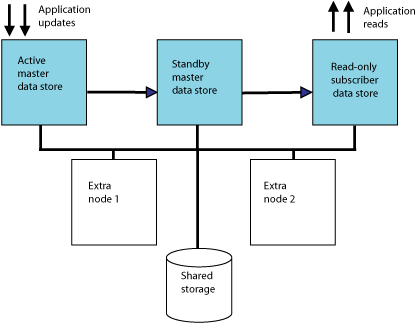
You can use Oracle Clusterware to start, monitor and automatically fail over TimesTen applications in response to node failures and other events. See "Planned maintenance" and "Recovering from failures" for details.
Oracle Clusterware can be implemented at two levels of availability for TimesTen. The basic level of availability manages two master nodes and up to 127 read-only subscriber nodes in the cluster. The active standby pair is defined with physical host names and IP addresses. If both master nodes fail, user intervention is necessary to migrate the active standby scheme to new hosts. When both master nodes fail, Oracle Clusterware notifies the user.
The advanced level of availability uses virtual IP addresses for the active, standby and read-only subscriber data stores. Extra nodes can be included in the cluster that are not part of the initial active standby pair. If a failure occurs, the use of virtual IP addresses allows one of the extra nodes to take on the role of a failed node automatically.
If your applications connect to TimesTen in a client/server configuration, automatic client failover enables the client to reconnect automatically to the master data store with the active role after a failure. See "Working with the TimesTen Client and Server" in Oracle TimesTen In-Memory Database Operations Guide and "TTC_FailoverPortRange" in Oracle TimesTen In-Memory Database Reference.
The ttCWAdmin utility is used to administer TimesTen active standby pairs in a cluster that is managed by Oracle Clusterware. The configuration for each active standby pair is stored in an initialization file called cluster.oracle.ini by default. The information in this file is used to create Oracle Clusterware resources. Resources are used to manage each TimesTen daemon, data store, TimesTen processes, user applications and virtual IP addresses. For more information about the ttCWAdmin utility, see "ttCWAdmin" in Oracle TimesTen In-Memory Database Reference. For more information about the cluster.oracle.ini file, see "The cluster.oracle.ini file".
You can use Oracle Clusterware to manage these configurations:
Active standby pair with or without read-only subscribers
Active standby pair (with or without read-only subscribers) with AWT cache groups
Active standby pair (with or without read-only subscribers) with read-only cache groups
Active standby pair (with or without read-only subscribers) with AWT cache groups and read-only cache groups
The user must be the TimesTen instance administrator and must belong to the same operating system group as the Oracle Clusterware installation user.
On UNIX and Linux platforms, these ttCWAdmin commands must be executed by the root user:
ttCWAdmin -createVIPs ttCWAdmin -dropVIPs
See Oracle Clusterware Administration and Deployment Guide for network and storage requirements and information about Oracle Clusterware configuration files.
Oracle Clusterware and TimesTen should be installed in the same location on all nodes.
All machines should use Network Time Protocol (NTP) or a similar system to remain within 250 milliseconds of each other. This prevents Oracle Clusterware from unnecessarily restarting machines.
When you use Oracle Clusterware to manage an active standby pair, do not use these commands and SQL statements:
CREATE ACTIVE STANDBY PAIR, ALTER ACTIVE STANDBY PAIR and DROP ACTIVE STANDBY PAIR SQL statements
ttAdmin and ttRepAdmin -duplicate utilities
ttRepStart and ttRepStop built-in procedures
In addition, do not call ttDaemonAdmin -stop before calling ttCWAdmin -shutdown.
For more information about the built-ins and utilities, see Oracle TimesTen In-Memory Database Reference. For more information about the SQL statements, see Oracle TimesTen In-Memory Database SQL Reference.
The configuration for each active standby pair is stored in an initialization file called cluster.oracle.ini. The information in this file is used to create Oracle Clusterware resources that manage TimesTen daemons, data stores, TimesTen processes, user applications and virtual IP addresses.
The user creates the cluster.oracle.ini file as a text file and places it in the daemon home directory. By default this directory is:
The install_dir/info directory on Linux and UNIX
The c:\TimesTen\install_dir\srv\info directory on Windows
All of the attributes that can be used in the cluster.oracle.ini file are described in "Clusterware Attributes for TimesTen" in Oracle TimesTen In-Memory Database Reference.
The entry name in the cluster.oracle.ini file must be the same as an existing DSN:
In the sys.odbc.ini file on Linux or UNIX
In a system DSN on Windows
For example, [basicDSN] in the cluster.oracle.ini file described in "Configuring basic availability" must exist in the sys.odbc.ini file.
This section includes sample cluster.oracle.ini files for these configurations:
This example shows an active standby pair with no subscribers. The hosts for the active master data store and the standby master data store are host1 and host2. The list of hosts is delimited by commas. You can include spaces for readability if desired.
When the ttCWAdmin utility creates a profile for the active standby pair, it creates scripts that are placed in the location specified by the ScriptInstallDir attribute.
[basicDSN] MasterHosts=host1,host2 ScriptInstallDir=/mycluster/TTscripts
This is an example of a cluster.oracle.ini file for an active standby pair with one subscriber on host3:
[basicSubscriberDSN] MasterHosts=host1,host2 SubscriberHosts=host3 ScriptInstallDir=/mycluster/TTscripts
On Windows, the format of the ScriptInstallDir attribute is similar to this:
ScriptInstallDir=c:\mycluster\TTscripts
The hosts for the active master data store and the standby master data store are host1 and host2. host3 and host4 are extra nodes that can be used for failover. There are no subscriber nodes. MasterVIP specifies the virtual IP addresses defined for the master data stores. VIPInterface is the name of the public network adaptor. VIPNetMask defines the netmask of the virtual IP addresses.
[advancedDSN] MasterHosts=host1,host2,host3,host4 ScriptInstallDir=/mycluster/TTscripts MasterVIP=192.168.1.1, 192.168.1.2 VIPInterface=eth0 VIPNetMask=255.255.255.0
This example has one subscriber on host4. There is one extra node that can be used for failing over the master data stores and one extra node that can be used for the subscriber data store. MasterVIP and SubscriberVIP specify the virtual IP addresses defined for the master and subscriber data stores. VIPInterface is the name of the public network adaptor. VIPNetMask defines the netmask of the virtual IP addresses.
[advancedSubscriberDSN] MasterHosts=host1,host2,host3 SubscriberHosts=host4,host5 ScriptInstallDir=/mycluster/TTscripts MasterVIP=192.168.1.1, 192.168.1.2 SubscriberVIP=192.168.1.3 VIPInterface=eth0 VIPNetMask=255.255.255.0
Ensure that the extra nodes:
Have TimesTen installed
Have the direct-linked application installed if this is part of the configuration. See "Implementing application failover".
Have a copy of the cluster.oracle.ini file in the same location as the other hosts.
If the active standby pair replicates one or more AWT or read-only cache groups, set the CacheConnect attribute to y.
This example specifies an active standby pair with one subscriber in an advanced availability configuration. The active standby pair replicates one or more cache groups.
[advancedCacheDSN] MasterHosts=host1,host2,host3 SubscriberHosts=host4, host5 ScriptInstallDir=/mycluster/TTscripts MasterVIP=192.168.1.1, 192.168.1.2 SubscriberVIP=192.168.1.3 VIPInterface=eth0 VIPNetMask=255.255.255.0 CacheConnect=y
TimesTen integration with Oracle Clusterware can facilitate the failover of an application that is linked to any of the data stores in the active standby pair. Both direct-linked and client/server applications that are on the same machine as Oracle Clusterware and TimesTen can be managed.
The required attributes for failing over an application are:
AppName - Name of the application to be managed by Oracle Clusterware
AppStartCmd - Command line for starting the application
AppStopCmd - Command line for stopping the application
AppCheckCmd - Command line for executing an application that checks the status of the application specified by AppName
AppType - Determines the data store to which the application is linked. The possible values are Active, Standby, and Subscriber[index].
Optionally, you can also set AppFailureThreshold, AppFailoverDelay, and AppScriptTimeout. These attributes have default values.
Oracle Clusterware uses the user-supplied script or program specified by AppCheckCmd to monitor the application. The script that checks the status of the application must be written to return 0 for success and a nonzero number for failure. When Oracle Clusterware detects a nonzero value, it takes action to recover the failed application.
This example shows advanced availability configured for an active standby pair with with no subscribers. The reader application is an application that queries the data in the standby data store.
[appDSN] MasterHosts=host1,host2,host3,host4 ScriptInstallDir=/mycluster/TTscripts MasterVIP=192.168.1.1, 192.168.1.2 VIPInterface=eth0 VIPNetMask=255.255.255.0 AppName=reader AppType=Standby AppStartCmd=/mycluster/reader/app_start.sh AppStopCmd=/clusterware/reader/app_stop.sh AppCheckCmd=/clusterware/reader/app_check.sh
AppStartCmd, AppStopCmd and AppCheckCmd can include arguments. For example, consider a valid cluster.oracle.ini file on Windows. In this example the application is directly linked to the active master data store. The script for starting, stopping, and checking the application takes arguments for the DSN and the action to take (-start, -stop and -check).
Note the double quotes for the specified paths in AppStartCmd, AppStopCmd and AppCheckCmd. The quotes are needed because there are spaces in the path.
[appWinDSN] MasterHosts=host1,host2,host3,host4 ScriptInstallDir=C:\Cluster Files\TTscripts MasterVIP=192.168.1.1, 192.168.1.2 VIPInterface=Local Area Connection VIPNetMask=255.255.255.0 AppName=UpdateApp AppType=Active AppStartCmd="C:\Program Files\UserApps\UpdateApp.exe" -dsn myDSN -start AppStopCmd= "C:\Program Files\UserApps\UpdateApp.exe" -dsn myDSN -stop AppCheckCmd="C:\Program Files\UserApps\UpdateApp.exe" -dsn myDSN -check
You can configure failover for more than one application. Use AppName to name the application and provide values for AppType, AppStartCmd, AppStopCmd and AppCheckCmd immediately following the AppName attribute. You can include blank lines for readability. For example:
[app2DSN] MasterHosts=host1,host2,host3,host4 ScriptInstallDir=/mycluster/TTscripts MasterVIP=192.168.1.1, 192.168.1.2 VIPInterface=eth0 VIPNetMask=255.255.255.0 AppName=reader AppType=Standby AppStartCmd=/mycluster/reader/app_start.sh AppStopCmd=/clusterware/reader/app_stop.sh AppCheckCmd=/clusterware/reader/app_check.sh AppName=update AppType=Active AppStartCmd=/mycluster/update/app2_start.sh AppStopCmd=/clusterware/update/app2_stop.sh AppCheckCmd=/clusterware/update/app2_check.sh
If both master nodes fail, Oracle Clusterware can automatically recover the master data stores to two new nodes. Automatic recovery requires:
Advanced availability (virtual IP addresses and at least four hosts)
No cache groups on the active standby pair data stores
AutoRecover set to y
RepBackupDir specifies a directory on shared storage
RepBackupPeriod must be set to a value greater than 0
TimesTen first performs a full backup of the active master data store and then performs incremental backups. You can specify the optional attribute RepfullbackupCycle to manage when TimesTen performs subsequent full backup. By default, TimesTen performs a full backup after every five incremental backups.
If RepBackupDir and RepBackupPeriod are configured for backups, TimesTen performs backups for any master data store that becomes active. It does not delete backups that were performed for a data store that used to be active and has become the standby unless the data store becomes active again. Ensure that the shared storage has enough space for two complete data store backups. ttCWAdmin -restore automatically chooses the correct backup files.
TimesTen uses the ttBackup utility to perform backups. Incremental backups affect the amount of log records in the transaction log file. Ensure that the values of RepBackupPeriod and RepfullbackupCycle are small enough to prevent a large amount of log records in the transaction log file. For more information about the interaction between backups and log records, see "ttBackup" in Oracle TimesTen In-Memory Database Reference.
This example shows attribute settings for automatic recovery.
[autorecoveryDSN]
MasterHosts=host1,host2,host3,host4
ScriptInstallDir=/mycluster/TTscripts
MasterVIP=192.168.1.1, 192.168.1.2
VIPInterface=eth0
VIPNetMask=255.255.255.0
AutoRecover=y
RepBackupDir=/shared_drive/dsbackup
RepBackupPeriod=3600
If you have cache groups in the active standby pair or prefer to recover manually from failure of both master hosts, ensure that AutoRecover is set to n (the default). Manual recovery requires:
RepBackupDir specifies a directory on shared storage
RepBackupPeriod must be set to a value greater than 0
This example shows attribute settings for manual recovery. The default value for AutoRecover is n, so it is not included in the file.
[manrecoveryDSN]
MasterHosts=host1,host2,host3
ScriptInstallDir=/mycluster/TTscripts
MasterVIP=192.168.1.1, 192.168.1.2
VIPInterface=eth0
VIPNetMask=255.255.255.0
RepBackupDir=/shared_drive/dsbackup
RepBackupPeriod=3600
The RepDDL attribute represents the SQL statement that creates the active standby pair. The RepDDL attribute is optional. You can use it to exclude tables, cache groups and sequences from the active standby pair.
If you include RepDDL in the cluster.oracle.ini file, you do not need to include ReturnServiceAttribute, MasterStoreAttribute and SubscriberStoreAttribute.
When you specify a value for RepDDL, use <DSN> for the data store file name prefix and placeholders for the host names, such as <MASTERHOST[1]> and <MASTERHOST[2]>.
Use the RepDDL attribute to exclude tables, cache groups and sequences from the active standby pair:
[excludeDSN] MasterHosts=host1,host2,host3,host4 ScriptInstallDir=/mycluster/TTscripts MasterVIP=192.168.1.1, 192.168.1.2 VIPInterface=eth0 VIPNetMask=255.255.255.0 RepDDL=CREATE ACTIVE STANDBY PAIR \ <DSN> ON <MASTERHOST[1]>, <DSN> ON <MASTERHOST[2]>,\ EXCLUDE TABLE pat.salaries, \ EXCLUDE CACHE GROUP terry.salupdate, \ EXCLUDE SEQUENCE ttuser.empcount
Usually, Oracle Clusterware provides routing information to the TimesTen replication agent. If you are using network interfaces that Oracle Clusterware is not aware of, you can specify them in the ROUTE clause in RepDDL.
Note:
Do not specify a ROUTE clause if you are configuring advanced availability.[routeDSN] MasterHosts=host1,host2,host3,host4 ScriptInstallDir=/mycluster/TTscripts RepDDL=CREATE ACTIVE STANDBY PAIR \ <DSN> ON <MASTERHOST[1]>, <DSN> ON <MASTERHOST[2]>,\ ROUTE MASTER <DSN> ON <MASTERHOST[1]> SUBSCRIBER <DSN> ON <MASTERHOST[2]>\ MASTERIP "192.168.1.2" PRIORITY 1\ SUBSCRIBERIP "192.168.1.3" PRIORITY 1\ MASTERIP "10.0.0.1" PRIORITY 2\ SUBSCRIBERIP "10.0.0.2" PRIORITY 2\ MASTERIP "140.87.11.203" PRIORITY 3\ SUBSCRIBERIP "140.87.11.204" PRIORITY 3\ ROUTE MASTER <DSN> ON <MASTERHOST[2]> SUBSCRIBER <DSN> ON <MASTERHOST[2]>\ MASTERIP "192.168.1.3" PRIORITY 1\ SUBSCRIBERIP "192.168.1.2" PRIORITY 1\ MASTERIP "10.0.0.2" PRIORITY 2\ SUBSCRIBERIP "10.0.0.1" PRIORITY 2\ MASTERIP "140.87.11.204" PRIORITY 3\ SUBSCRIBERIP "140.87.11.203" PRIORITY 3\
To create and initialize a cluster, perform these tasks:
If you plan to have more than one active standby pair in the cluster, see "Including more than one active standby pair in a cluster".
Install Oracle Clusterware. By default the installation occurs on all hosts concurrently. See Oracle Clusterware Administration and Deployment Guide for details.
Oracle Clusterware starts automatically after successful installation.
Install TimesTen in the same location on each host in the cluster, including extra hosts.
On Linux and UNIX, the installer prompts you for values for:
The T CP/IP port number associated with the TimesTen cluster agent. If you do not provide a port number, TimesTen uses the default TimesTen port.
The Oracle Clusterware location.
The hosts included in the cluster, including spare hosts, with host names separated by commas
The installer uses these values to create the ttcrsagent.options file.
The ttcrsagent.options file must be the same on every host. On Linux, you can use the -record and -batch options for setup.sh to perform identical installations on additional hosts. See "TimesTen Installation" in Oracle TimesTen In-Memory Database Installation Guide for details.
On Windows, execute ttmodinstall -crs after installation to create the ttcrsagent.options file. You can also use the ttmodinstall utility to create the ttcrsagent.options file on existing installations on other platforms. For more information about ttmodinstall, see "ttmodinstall" in Oracle TimesTen In-Memory Database Reference.
Start the TimesTen cluster agent by executing the ttCWAdmin -init command on one of the hosts. For example:
ttCWAdmin -init
When the TimesTen cluster agent has started, Oracle Clusterware begins monitoring the TimesTen daemon and will restart it if it fails.
Create a data store on the host where you intend the active master data store to reside. The DSN must be the same as the data store file name.
Create schema objects such as tables, AWT cache groups and read-only cache groups.
Create a cluster.oracle.ini file. See "The cluster.oracle.ini file" for details about its contents and location.
For advanced availability, execute the ttCWAdmin -createVIPs command on any host in the cluster. On UNIX, you must execute this command as the root user. For example:
ttCWAdmin -createVIPs -dsn myDSN
Create an active standby pair replication scheme by executing the ttCWAdmin -create command on any host. For example:
ttCWAdmin -create -dsn myDSN
This command prompts for an encryption pass phrase that the user will not need again. The command also prompts for the user ID and password for an internal user with the ADMIN privilege if it does not find this information in the sys.odbc.ini file. This internal user will be used to create the active standby pair.
If CacheConnect is enabled, the command prompts for the user password for the Oracle database. The Oracle password is used to set the autorefresh states for cache groups.
Start the active standby pair replication scheme by executing the ttCWAdmin -start command on any host. For example:
ttCWAdmin -start -dsn myDSN
If you want to use Oracle Clusterware to manage more than one active standby pair in a cluster, include additional configurations in the cluster.oracle.ini file. For example, this cluster.oracle.ini file contains configuration information for two active standby pair replication schemes:
[advancedSubscriberDSN] MasterHosts=host1,host2,host3 SubscriberHosts=host4, host5 ScriptInstallDir=/mycluster/TTscripts MasterVIP=192.168.1.1, 192.168.1.2 SubscriberVIP=192.168.1.3 VIPInterface=eth0 VIPNetMask=255.255.255.0 [advSub2DSN] MasterHosts=host1,host2,host3 SubscriberHosts=host4, host5 ScriptInstallDir=/mycluster/TTscripts MasterVIP=192.168.1.4, 192.168.1.5 SubscriberVIP=192.168.1.6 VIPInterface=eth0 VIPNetMask=255.255.255.0
Perform these tasks for additional replication schemes:
Create and populate the data stores.
Create the virtual IP addresses. Use the ttCWAdmin -createVIPs command.
Create the active standby pair replication scheme. Use the ttCWAdmin -create command.
Start the active standby pair. Use the ttCWAdmin -start command.
Oracle Clusterware can recover automatically from many kinds of failures. This section describes several failure scenarios and how Oracle Clusterware manages the failures.
This section includes these topics:
If there is a failure on the node where the active master data store resides, Oracle Clusterware automatically changes the state of the standby master data store to 'ACTIVE'. If application failover is configured, then the application begins updating the new active master data store.
Figure 6-2 shows that the state of the standby master data store has changed to 'ACTIVE' and that the application is updating the new active master data store.
Figure 6-2 Standby master data store becomes active
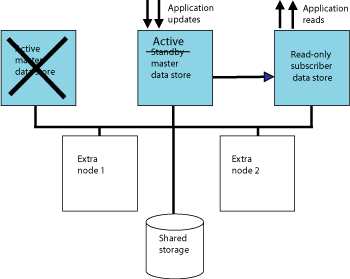
Oracle Clusterware tries to restart the data store or host where the failure occurred. If it is successful, then that data store becomes the standby master data store.
Figure 6-3 shows a cluster where the former active node becomes the standby node.
Figure 6-3 Standby master data store starts on former active host
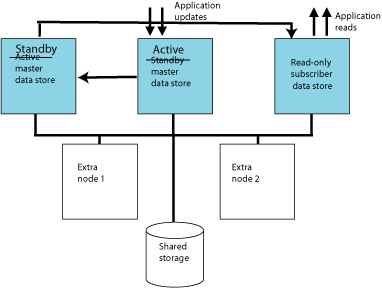
If the failure of the former active node is permanent and advanced availability is configured, Oracle Clusterware starts a standby master data store on one of the extra nodes.
Figure 6-4 shows a cluster in which the standby master data store is started on one of the extra nodes.
Figure 6-4 Standby master data store starts on extra host
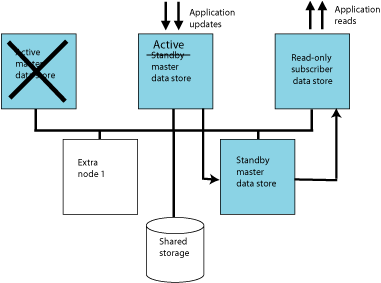
If there is a failure on the standby node, Oracle Clusterware first tries to restart the data store or host. If it cannot restart the standby data store on the same host and advanced availability is configured, Oracle Clusterware starts the standby data store on an extra node.
Figure 6-5 shows the standby data store on a new host after a failure.
Figure 6-5 Standby master data store on new host
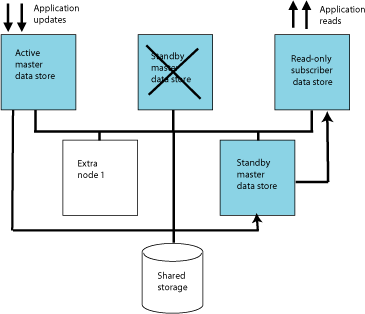
If there is a failure on a subscriber node, Oracle Clusterware first tries to restart the data store or host. If it cannot restart the data store on the same host and advanced availability is configured, Oracle Clusterware starts the subscriber data store on an extra node.
This section includes these topics:
Oracle Clusterware can achieve automatic recovery from failure on both master nodes if:
Advanced availability is configured (virtual IP addresses and at least four hosts)
No cache groups are replicated by the active standby pair
AutoRecover is set to y
RepBackupDir specifies a directory on shared storage
RepBackupPeriod is set to a value greater than 0
See "Recovering from failure of both master nodes" for examples of cluster.oracle.ini files.
This section assumes that the failed master nodes will be recovered to new hosts.
To perform manual recovery in an advanced availability configuration, perform these tasks:
If the new hosts are not already specified by MasterHosts and SubscriberHosts in the cluster.oracle.ini file, then modify the file to include the new hosts. This example uses manrecoveryDSN. This step is not necessary for manrecoveryDSN because extra hosts are already specified in the cluster.oracle.ini file.
Ensure that the TimesTen cluster agent is running on the local host.
ttCWAdmin -init -hosts localhost
Restore the backup data store. Ensure that there is not already a data store on the host with the same DSN as the data store you want to restore.
ttCWAdmin -restore -dsn manrecoveryDSN
If there are cache groups in the data store, drop and re-create the cache groups.
Re-create the active standby pair replication scheme.
ttCWAdmin -create -dsn manrecoveryDSN
Start the active standby pair replication scheme.
ttCWAdmin -start -dsn manrecoveryDSN
This section assumes that the failed master nodes will be recovered to new hosts.
To perform manual recovery in a basic availability configuration, perform these steps:
Acquire new hosts for the data stores in the active standby pair.
Update the MasterHosts and SubscriberHosts entries in the cluster.oracle.ini file. This example uses the basicDSN data store.
Ensure that the TimesTen cluster agent is running on the local host.
ttCWAdmin -init -hosts localhost
Restore the backup data store. Ensure that there is not already a data store on the host with the same DSN as the data store you want to restore.
ttCWADmin -restore -dsn basicDSN
If there are cache groups in the data store, drop and re-create the cache groups.
Re-create the active standby pair replication scheme.
ttCWAdmin -create -dsn basicDSN
Start the active standby pair replication scheme.
ttCWAdmin -start -dsn basicDSN
Approach a failure of more than two master hosts as a more extreme case of dual host failure. Use these guidelines:
Address the root cause of the failure if it is something like a power outage or network failure.
Identify or obtain at least two healthy hosts for the active and standby master data stores.
Update the MasterHosts and SubscriberHosts entries in the cluster.oracle.ini file.
See "Manual recovery for advanced availability" and "Manual recovery for basic availability" for guidelines on subsequent actions to take.
This section includes the following topics:
Schema changes like altering a table can be performed directly on the active master data store. The changes will be replicated to the other data stores in the active standby pair.
If you want to create or drop a table or cache group from an active standby pair in a cluster, perform the following tasks:
Stop the replication agents on the data stores in the active standby pair. These commands use the advancedCacheDSN as an example.
ttCWAdmin -stop -dsn advancedCacheDSN
Drop the active standby pair.
ttCWAdmin -drop -dsn advancedCacheDSN
Modify the schema as desired.
Re-create the active standby pair replication scheme.
ttCWAdmin -create -dsn advancedCacheDSN
Start the active standby pair replication scheme.
ttCWAdmin -start -dsn advancedCacheDSN
To upgrade TimesTen on one host, perform these tasks:
Stop the replication agents on the data stores in the active standby pair.
ttCWAdmin -stop -dsn advancedDSN
Stop the TimesTen cluster agent on the host. This removes the host from the cluster and stops the TimesTen daemon.
ttCWAdmin -shutdown -hosts localhost
Upgrade TimesTen on the host. If you are upgrading between major releases, use the ttMigrate utility. See "Data Store Upgrades" in Oracle TimesTen In-Memory Database Installation Guide.
Start the TimesTen cluster agent. This includes the host in the cluster and starts the TimesTen daemon.
ttCWAdmin -init
To perform a rolling upgrade of TimesTen across the cluster, perform the tasks on each host.
To add a read-only subscriber to an active standby pair, perform these steps:
Stop the replication agents on all data stores. This example uses the advancedSubscriberDSN, which already has a subscriber and is configured for advanced availability.
ttCWAdmin -stop -dsn advancedSubscriberDSN
Drop the active standby pair.
ttCWAdmin -drop -dsn advancedSubscriberDSN
Modify the cluster.oracle.ini file.
Add the subscriber to the SubscriberHosts attribute.
If the cluster is configured for advanced availability, add a virtual IP address to the SubscriberVIP attribute.
See "Configuring advanced availability" for an example using these attributes
Create the active standby pair replication scheme.
ttCWAdmin -create -dsn advancedSubscriberDSN
Start the active standby pair replication scheme.
ttCWAdmin -start -dsn advancedSubscriberDSN
To remove a read-only subscriber to an active standby pair, perform these steps:
Stop the replication agents on all data stores. This example uses the advancedSubscriberDSN, which has a subscriber and is configured for advanced availability.
ttCWAdmin -stop -dsn advancedSubscriberDSN
Drop the active standby pair.
ttCWAdmin -drop -dsn advancedSubscriberDSN
Modify the cluster.oracle.ini file.
Remove the subscriber from the SubscriberHosts attribute or remove the attribute altogether if there are no subscribers left in the active standby pair.
Remove a virtual IP the SubscriberVIP attribute or remove the attribute altogether if there are no subscribers left in the active standby pair.
Create the active standby pair replication scheme.
ttCWAdmin -create -dsn advancedSubscriberDSN
Start the active standby pair replication scheme.
ttCWAdmin -start -dsn advancedSubscriberDSN
To add an active standby pair (with or without subscribers) to a cluster that is already managing an active standby pair, perform these tasks:
Create and populate a data store on the host where you intend the active master data store to reside initially. See "Create and populate a TimesTen data store on one host".
Modify the cluster.oracle.ini file. This example adds advSub2DSN to the cluster.oracle.ini file that already contains the configuration for advancedSubscriberDSN. The new active standby pair is on different hosts from the original active standby pair.
[advancedSubscriberDSN] MasterHosts=host1,host2,host3 SubscriberHosts=host4, host5 ScriptInstallDir=/mycluster/TTscripts MasterVIP=192.168.1.1, 192.168.1.2 SubscriberVIP=192.168.1.3 VIPInterface=eth0 VIPNetMask=255.255.255.0 [advSub2DSN] MasterHosts=host6,host7,host8 SubscriberHosts=host9, host10 ScriptInstallDir=/mycluster/TTscripts MasterVIP=192.168.1.4, 192.168.1.5 SubscriberVIP=192.168.1.6 VIPInterface=eth0 VIPNetMask=255.255.255.0
Create new virtual IP addresses. On Linux and UNIX, the user must be root to do this.
ttCWAdmin -createVIPs -dsn advSub2DSN
Create the new active standby pair replication scheme.
ttCWAdmin -create -dsn advSub2DSN
Start the new active standby pair replication scheme.
ttCWAdmin -start -dsn advSub2DSN
To remove an active standby pair (with or without subscribers) from a cluster, perform these tasks:
Stop the replication agents on all data stores in the active standby pair. This example uses advSub2DSN, which was added in "Adding an active standby pair to a cluster".
ttCWAdmin -stop -dsn advSub2DSN
Drop the active standby replication scheme.
ttCWAdmin -drop -dsn advSub2DSN
Drop the virtual IP addresses for the active standby pair.
ttCWAdmin -dropVIPs -dsn advSub2DSN
Modify the cluster.oracle.ini file (optional). Remove the entries for advSub2DSN.
If you want to destroy the data stores, log onto each host that was included in the configuration for this active standby pair and use the ttDestroy utility.
ttDestroy advSub2DSN
For more information about ttDestroy, see "ttDestroy" in Oracle TimesTen In-Memory Database Reference.
Adding a host requires that the cluster be configured for advanced availability.
To add a host to the cluster, perform these tasks:
Stop the replication agents. This example uses the example DSN advancedDSN.
ttCWAdmin -stop -dsn advancedDSN
Drop the active standby pair.
ttCWAdmin -drop -dsn advancedDSN
Modify the cluster.oracle.ini file. In this example, host5 is added to the list of master hosts.
[advancedDSN] MasterHosts=host1, host2, host3, host4, host5 ScriptInstallDir=/mycluster/TTscripts MasterVIP=192.168.1.1, 192.168.1.2 VIPInterface=eth0 VIPNetMask=255.255.255.0
Ensure that the TimesTen cluster agent is running on host5.
ttCWAdmin -init -hosts host5
Re-create the active standby pair replication scheme.
ttCWAdmin -create -dsn advancedDSN
Start the active standby pair replication scheme.
ttCWAdmin -start -dsn advancedDSN
Removing a host from the cluster requires that the cluster be configured for advanced availability. MasterHosts must list more than two hosts if one of the master hosts is to be removed. SubscriberHosts must list at least one more host than the number of subscriber data stores if one of the subscriber hosts is to be removed.
To remove a host from the cluster, perform these tasks:
Stop the replication agents. This example uses the example DSN advancedSubscriberDSN.
ttCWAdmin -stop -dsn advancedSubscriberDSN
Drop the active standby pair.
ttCWAdmin -drop -dsn advancedSubscriberDSN
Remove the host from the cluster. See "Adding and Deleting Oracle Clusterware Homes" in Oracle Clusterware Administration and Deployment Guide for details.
Modify the cluster.oracle.ini file by removing the host from the appropriate list of hosts. In this example, host5 has been removed from the list of subscriber hosts.
[advancedSubscriberDSN] MasterHosts=host1,host2,host3 SubscriberHosts=host4 ScriptInstallDir=/mycluster/TTscripts MasterVIP=192.168.1.1, 192.168.1.2 SubscriberVIP=192.168.1.3 VIPInterface=eth0 VIPNetMask=255.255.255.0
Re-create the active standby pair replication scheme.
ttCWAdmin -create -dsn advancedSubscriberDSN
Start the active standby pair replication scheme.
ttCWAdmin -start -dsn advancedSubscriberDSN
If you need to upgrade the operating system or hardware for a host or perform network maintenance, shut down Oracle Clusterware and disable automatic startup. Execute these Oracle Clusterware commands as root or OS administrator:
#crsctl stop crs #crsctl disable crs
Shut down TimesTen. See "Shutting down a TimesTen application" in Oracle TimesTen In-Memory Database Operations Guide.
Perform the host maintenance. Then enable automatic startup and start Oracle Clusterware:
#crsctl enable crs #crsctl start crs
See Oracle Clusterware Administration and Deployment Guide for more information about these commands.
When all of the hosts in the cluster need to be brought down, stop Oracle Clusterware on each host individually. Execute these Oracle Clusterware commands as root or OS administrator:
# crsctl stop crs #crsctl start crs
Shut down TimesTen. See "Shutting down a TimesTen application" in Oracle TimesTen In-Memory Database Operations Guide
Perform the maintenance. Then enable automatic startup and start Oracle Clusterware:
# crsctl enable crs # crsctl start crs